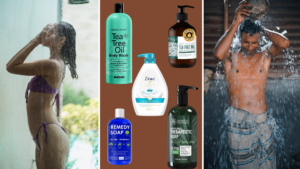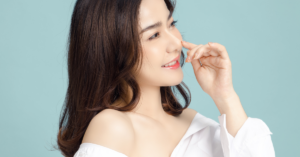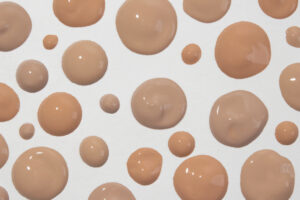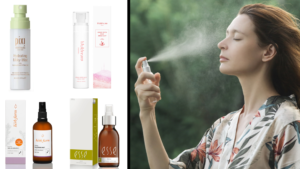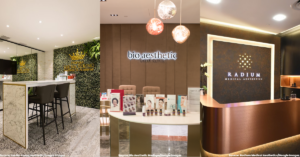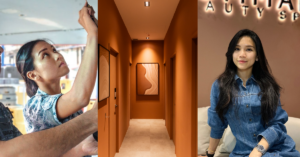#Insider Spotlight
Unveiling the Artistry of Anti-Ageing Aesthetic Treatments with Dr. Stephanie Young
Dr. Stephanie Young shares her insights, experiences, and aspirations in the field of ophthalmic plastic and reconstructive surgery.
By: Farah Khan / June 2, 2023

Dr. Stephanie Young, a Senior Consultant eye surgeon and Director of Ophthalmic Plastic & Reconstructive Surgery at Eagle Eye Centre, is making waves in the field of ophthalmic plastic and reconstructive surgery. With a special interest in eyelid surgery, she has successfully treated various conditions and has extensive knowledge in General Ophthalmology. Her impressive credentials include Fellowships from renowned institutions and numerous awards for her research and contributions.
Dr. Young’s expertise extends beyond her clinical practice. She actively engages in Oculoplastic-related research, with multiple publications in esteemed journals. Moreover, she is committed to giving back to society, serving on executive committees and participating in eye care initiatives in underserved areas.
In an exclusive interview, Dr. Stephanie Young shares her insights, experiences, and aspirations in the field of ophthalmic plastic and reconstructive surgery. Join us as we explore her remarkable career, compassionate patient care, unwavering pursuit of excellence, and anti-ageing treatments; BBL Hero and Forever Young BBL technology.

What inspired you to become an aesthetic doctor, and how has your training and experience shaped your approach to cosmetic treatments?
I am an Oculoplastic & Reconstructive Surgeon with a passion for enhancing the natural beauty of my patients’ eyes and surrounding tissue. My education includes 5 years of medical school, 1 year of Housemanship, 6 years of training in Ophthalmology, and 3 years of specialised training in Ophthalmic plastic and reconstructive surgery through two fellowships.
Throughout my career, I have seen the importance of surgical and non-surgical rejuvenation for the eyelids and surrounding structures. After hearing the growing demand from my patients for aesthetic treatments, I decided to expand the Oculoplastic practice and co-founded Eagle Aesthetics & Surgery, a subsidiary of Eagle Eye Centre. My primary focus is on cosmetic eyelid surgery, which includes a range of procedures such as blepharoplasty, double eyelid surgery, ptosis or droopy eyelid surgery, and
revisional eyelid surgery for correcting previous surgery. In addition, I offer non-surgical eyelid and facial rejuvenation using Botox, lasers, light, peels and fillers to address eyelid bags, dark circles, facial scars and signs of aging.
I take great pride in helping my patients achieve their desired results, and I’m committed to providing the highest level of care and expertise to every patient who walks through my doors.

How do you evaluate a patient’s needs and goals when recommending aesthetic treatments, and what factors do you consider when developing a treatment plan?
When evaluating a patient for aesthetic treatments, I try to understand their needs and goals. The patient’s medical history, skin type, lifestyle, and expectations are taken into consideration. A treatment plan is then developed based on the patient’s individual needs and goals, taking into account factors such as the type and severity of the condition being treated, the patient’s desired outcome, and any potential risks or limitations of the treatment.
Some patients are new to aesthetics and may not be open to more aggressive treatments. I may propose a more gentle and non-invasive treatment like light therapy (a good example is BBL Hero), which has no downtime and gently rejuvenates the skin. There are others who have tried all kinds of lasers, but are looking for something stronger to turn back years of sun and age damage to the skin. I may recommend a hybrid fractional laser to these patients such as Halo laser which combines ablative and non-ablative wavelengths to give accelerated skin rejuvenation outcomes. There are those who are obvious surgical candidates, e.g. severe droopy eyelids or puffy eyebags, and I will let them know the upper or lower blepharoplasty may be their best options.
Can you describe some of the most popular cosmetic treatments that you offer in your practice, and how do they work to enhance a patient’s appearance?
As an oculoplastic surgeon, I offer a variety of surgical and non-surgical cosmetic treatments that can help enhance a patient’s appearance. Here are some of the most popular cosmetic treatments that I offer and how they work:
- Blepharoplasty: Also known as eyelid surgery, blepharoplasty is a cosmetic procedure that involves removing excess skin and fat from the eyelids. This can help improve the appearance of sagging or puffy eyelids, giving the patient a more youthful and refreshed look.
- Injectables: These include botulinum toxin (commonly known as Botox) which help reduce the appearance of wrinkles and fine lines, particularly around the eyes, forehead, and mouth. Dermal filler is another popular cosmetic injectable. These are gel-like substance injected into the skin to add volume and fill in wrinkles and lines. Common areas for treatment include the cheeks, lips, and under-eye area. Increasingly collagen stimulators are also gaining popularity as an injectable
treatment for their more natural and long-lasting results. - Brow lift: A brow lift is a cosmetic procedure that involves lifting and tightening the skin and muscles of the forehead and brow area. This can help reduce the appearance of sagging or drooping eyebrows and give the patient a more youthful and alert appearance.
- Light and laser treatments: These are non-surgical cosmetic procedures that use specialized light sources to target and improve various skin conditions. Some of the most common light and laser treatments for skin:
Intense Pulsed Light (IPL): IPL is a non-invasive treatment that uses a broad spectrum of light to improve the appearance of sun damage, age spots, rosacea, and other skin conditions. The light penetrates the skin and is absorbed by pigments in the skin, causing them to break down and fade over time. We love the BBL Hero by Sciton in our clinic. It is an advanced and powerful version of IPL with increased safety profile.
Fractional laser resurfacing: Fractional laser resurfacing is a non-surgical treatment that uses a laser to target small areas of skin, creating tiny injuries that stimulate the skin’s natural healing process. This can help reduce the appearance of fine lines, wrinkles, acne scars, and other skin imperfections. We love the HALO laser in our clinic. It is a high-end skin resurfacing laser
that operates using two distinct wavelengths (ablative and non-ablative) to target your skin concerns on multiple levels.
Each of the above treatments can be tailored to meet the specific needs and goals of the
patient, and can help enhance their appearance in different ways.

Are there any new or emerging aesthetic treatments that you are particularly excited about, and how do they differ from traditional approaches to cosmetic enhancement?
There are several emerging aesthetic treatments that I am excited about. These include more advanced lasers like the HALO laser, microneedling with radiofrequency (RF), collagen stimulators, and exosomes. The HALO laser is a hybrid fractional laser that combines two laser wavelengths to provide more precise and customisable treatments for a variety of skin concerns. Microneedling with RF combines microneedling with radiofrequency energy to stimulate collagen production and improve skin texture and
tone. Collagen stimulators are injectable treatments that gradually improve the skin’s overall appearance and texture by stimulating collagen production. Exosomes, small membrane-bound vesicles that contain various biomolecules, are being studied for their potential to promote skin rejuvenation and repair, particularly those derived from stem cells.
These emerging aesthetic treatments differ from traditional approaches to cosmetic enhancement in that they are minimally invasive, require little to no downtime, and offer natural-looking results. They also tend to be less expensive than traditional cosmetic procedures and may be more suitable for patients who are not candidates for surgery. As with any cosmetic treatment, it’s important to consult with a qualified medical professional to determine which treatment is best suited to your individual needs and goals.
How do you approach the balance between achieving natural-looking results and meeting a patient’s expectations for a specific aesthetic outcome?
As an oculoplastic surgeon, the approach to balancing natural-looking results with meeting a patient’s expectations for a specific aesthetic outcome is a delicate and personalized process. First and foremost, it’s important to have a thorough consultation with the patient to understand their concerns and goals. This involves assessing their unique facial anatomy, skin type, and overall health to determine the most appropriate treatment plan. The surgeon must also take into consideration any medical conditions or medications that the patient may be taking that could impact their treatment. During the consultation, the surgeon should discuss the various treatment options available, including their potential risks and benefits, as well as the expected outcome. They should also provide the patient with realistic expectations for the outcome, taking into account the patient’s facial anatomy and skin type.
The surgeon should work with the patient to develop a treatment plan that balances their aesthetic goals with achieving a natural-looking result. This may involve combining different treatments to achieve the desired outcome or adjusting the treatment plan to ensure that the result looks balanced and harmonious with the patient’s overall facial features.
It’s also important for the surgeon to provide the patient with detailed post-treatment care instructions, including any necessary follow-up appointments, to ensure that the patient achieves the best possible outcome. Overall, the key to achieving a balance between natural-looking results and meeting a
patient’s expectations for a specific aesthetic outcome is through open communication, careful planning, and a personalised approach to treatment.
Can you explain how Forever Young BBL technology works and what makes it unique in terms of anti-aging treatments?
Forever Young BBL (BroadBand Light) technology is a type of light therapy that uses pulsed broadband light to address a range of skin concerns, including aging, sun damage, and uneven pigmentation. The treatment delivers light energy to the skin, which penetrates deep into the tissue and triggers a process called photorejuvenation.
Photorejuvenation works by stimulating the production of collagen and elastin, two proteins that are essential for healthy, youthful-looking skin. As we age, our skin produces less collagen and elastin, leading to wrinkles, fine lines, and sagging skin. Forever Young BBL technology helps to reverse this process by increasing collagen and elastin production, leading to smoother, firmer, and more youthful-looking skin. One of the unique aspects of Forever Young BBL technology is its ability to selectively
target specific areas of the skin, while leaving the surrounding tissue untouched. This allows for a more precise and targeted treatment that can address specific skin concerns without damaging the surrounding tissue.
Another unique aspect of Forever Young BBL technology is its ability to treat a wide range of skin types and conditions. The treatment can be customized to address specific skin concerns, including uneven pigmentation, sun damage, and acne scars, among others. It can also be used to improve the overall texture and tone of the skin, leading to a more radiant and youthful appearance.
Finally, one of the key benefits of Forever Young BBL technology is that it requires no downtime and has minimal side effects. Most patients are able to resume their normal activities immediately after treatment, with only minor redness and swelling that typically resolves within a few hours.
Overall, Forever Young BBL technology is a unique and effective anti-aging treatment that can help to address a range of skin concerns while providing a more youthful and radiant appearance.

What are the most common skin concerns that BBL Hero can effectively address, and how many sessions are typically needed to see results?
BBL Hero is a type of BroadBand Light (BBL) therapy that can effectively address a wide range of skin concerns, including sun damage, hyperpigmentation, fine lines, wrinkles, acne, and rosacea, among others. The treatment works by delivering intense pulsed light to the skin, which penetrates deep
into the tissue to stimulate collagen and elastin production, leading to firmer, smoother, and more youthful-looking skin.
The number of BBL Hero sessions needed to see results can vary depending on the individual and the severity of their skin concerns. Generally, patients will need 3-5 treatments spaced several weeks apart to achieve optimal results. Some patients may require more treatments depending on the severity of their skin concerns. Patients typically begin to see improvements in their skin after the first treatment, with
continued improvements over time as the collagen and elastin production increases. The full benefits of BBL Hero treatment may take several weeks to several months to become apparent, depending on the individual’s skin type and condition.
Can BBL Hero be used on all skin types and colours, and are there any potential risks of side effects associated with the treatment?
BBL Hero is a safe and effective treatment for a variety of skin concerns, and can be used on most skin types and colours. However, as with any medical procedure, there are some potential risks and side effects associated with the treatment, such as redness, swelling, and in rare cases, pigment changes or blistering. These risks are generally minimal and can be minimised by choosing a qualified and experienced skincare professional or physician to perform the treatment. Before proceeding with BBL Hero treatment, the provider should perform a thorough evaluation of your skin and discuss any potential risks or side effects with you in detail, so you can make an informed decision about your treatment options.
How does the HALO laser work and what types of skin concerns can it effectively treat?
The HALO laser is a hybrid fractional laser that combines ablative and non-ablative wavelengths to treat a wide range of skin concerns. It works by creating micro-injuries in the skin, triggering the body’s natural healing response and stimulating collagen and elastin production. This process helps to improve skin texture, reduce the appearance of fine lines and wrinkles, and minimise skin discolouration such as age spots, sun damage, and uneven pigmentation.
The HALO laser can effectively treat various skin concerns, including sun damage, uneven pigmentation, acne scars, and fine lines and wrinkles. It can also improve skin texture and tone, resulting in a smoother, more youthful-looking complexion. Additionally, the HALO laser’s customisable settings allow for tailored treatment plans that can be adjusted to the specific needs of each patient, providing optimal results.
Can you describe the HALO GLOW that patients commonly experience after treatment, and how long does it typically last?
The HALO GLOW is a common experience that patients may notice after undergoing a HALO laser treatment. It is characterised by a radiant, healthy-looking complexion that appears brighter, smoother, and more youthful. The HALO GLOW typically lasts for several weeks following the treatment, as the
skin continues to heal and regenerate. However, the duration of the HALO GLOW can vary depending on the patient’s skin type, the severity of their skin concerns, and other factors. In general, patients can expect to see noticeable improvements in their skin’s appearance and texture within a few days to a week after the treatment, with continued improvement over several weeks as the collagen production increases.
Are there any particular pre- or post- treatment instructions that patients should follow when undergoing BBL Hero or HALO treatments?
Before the treatments, patients should avoid sun exposure and tanning, and refrain from using certain skincare products, medications, and supplements that can increase the risk of complications. After the treatment, patients should protect their skin from the sun and avoid certain activities that can irritate the skin, such as hot showers, steam rooms, and rigorous exercise. Patients may also need to apply soothing creams and ointments and avoid certain skincare products for a period of time after the treatment. For patients who have undergone the HALO laser, they may also experience some mild redness, swelling, and peeling, which is a normal part of the skin’s natural healing process. Patients should avoid picking or scratching at the treated area and follow their doctor’s specific post-treatment instructions to ensure the best possible results.
Looking to the future, what do you see as the most significant trends and developments in the field of aesthetic medicine, and how do you plan to stay at the forefront of these changes?
The field of aesthetic medicine is constantly evolving, and there are several trends and developments that are expected to shape its future. These include technology advancements such as the use of artificial intelligence and machine learning algorithms to personalise treatments. There is also a growing demand for non-invasive treatments that offer minimal downtime and fewer risks compared to traditional surgical procedures.
Surgery will always have a place in aesthetics, but improved techniques will hopefully lead to reduced downtime and better outcomes. The trend is also towards holistic approaches that focus on overall health and wellness. The concept of a one-size-fits-all approach to aesthetic medicine is fading, and customised treatment plans tailored to the individual patient are becoming more popular. Regenerative medicine techniques such as stem cells and platelet-rich plasma are being explored for their potential to rejuvenate and repair damaged tissues.
To stay at the forefront of these changes, I strongly believe that we aesthetic practitioners and surgeons must stay up-to-date on the latest technologies and techniques, and continually educate ourselves on best practices and emerging trends. We should attend industry conferences, participate in training programs, and collaborate with other practitioners to exchange knowledge and ideas. Ultimately, the key to success in the field of aesthetic medicine is a commitment to ongoing learning and a dedication to providing the highest quality care to patients.

